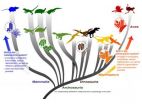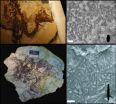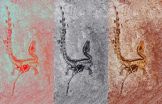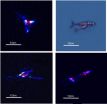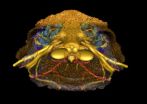(Press-News.org) New research that revises the rules allowing scientists to decipher color in dinosaurs may also provide a tool for understanding the evolutionary emergence of flight and changes in dinosaur physiology prior to its origin.
In a survey comparing the hair, skin, fuzz and feathers of living terrestrial vertebrates and fossil specimens, a research team from The University of Texas at Austin, the University of Akron, the China University of Geosciences and four other Chinese institutions found evidence for evolutionary shifts in the rules that govern the relationship between color and the shape of pigment-containing organelles known as melanosomes, as reported in the Feb. 13 edition of Nature.
At the same time, the team unexpectedly discovered that ancient maniraptoran dinosaurs, paravians, and living mammals and birds uniquely shared the evolutionary development of diverse melanosome shapes and sizes. (Diversity in the shape and size of melanosomes allows scientists to decipher color.) The evolution of diverse melanosomes in these organisms raises the possibility that melanosome shape and size could yield insights into dinosaur physiology.
Melanosomes have been at the center of recent research that has led scientists to suggest the colors of ancient fossil specimens covered in fuzz or feathers.
Melanosomes contain melanin, the most common light-absorbing pigment found in animals. Examining the shape of melanosomes from fossil specimens, scientists have recently suggested the color of several ancient species, including the fuzzy first-discovered feathered dinosaur Sinosauropteryx, and feathered species like Microraptor and Anchiornis.
According to the new research, color-decoding works well for some species, but the color of others may be trickier than thought to reconstruct.
Comparing melanosomes of 181 extant specimens, 13 fossil specimens and all previously published data on melanosome diversity, the researchers found that living turtles, lizards and crocodiles, which are ectothermic (commonly known as cold-blooded), show much less diversity in the shape of melanosomes than birds and mammals, which are endothermic (warm-blooded, with higher metabolic rates).
The limited diversity in melanosome shape among living ectotherms shows little correlation to color. The same holds true for fossil archosaur specimens with fuzzy coverings scientists have described as "protofeathers" or "pycnofibers." In these specimens, melanosome shape is restricted to spherical forms like those in modern reptiles, throwing doubt on the ability to decipher the color of these specimens from fossil melanosomes.
In contrast, in the dinosaur lineage leading to birds, the researchers found an explosion in the diversity of melanosome shape and size that appears to correlate to an explosion of color within these groups. The shift in diversity took place abruptly, near the origin of pinnate feathers in maniraptoran dinosaurs.
"This points to a profound change at a pretty discrete point," says author Julia Clarke of The University of Texas at Austin's Jackson School of Geosciences. "We're seeing an explosion of melanosome diversity right before the origin of flight associated with the origin of feathers."
What surprised the researchers was a similarity in the pattern of melanosome diversity among ancient maniraptoran dinosaurs, paravians, and living mammals and birds.
"Only in living, warm-blooded vertebrates that independently evolved higher metabolic rates do we see the melanosome diversity we also see in feathered dinosaurs," said co-author Matthew Shawkey of The University of Akron.
Many of the genes involved in the melanin color system are also involved in other core processes such as food intake, the stress axis, and reproductive behaviors. Because of this, note the researchers, it is possible that the evolution of diverse melanosome shapes is linked to larger changes in energetics and physiology.
Melanosome shape could end up offering a new tool for studying endothermy in fossil specimens, a notoriously challenging subject for paleontologists.
Because the explosion of diversity in melanosomes appears to have taken place right at the origin of pinnate feathers, the change may indicate that a key shift in dinosaurian physiology occurred prior to the origin of flight.
"We are far from understanding the exact nature of the shift that may have occurred," says Clarke. "But if changes in genes involved in both coloration and other aspects of physiology explain the pattern we see, these precede flight and arise close to the origin of feathers."
It is possible, notes Clarke, that a diversity in melanosome shape (and correlated color changes) resulted from an increased evolutionary role for signaling and sexual selection that had a carryover effect on physiology, or that a change in physiology closely preceded changes in color patterning. At this point, she stresses, both ideas are speculative.
"What is interesting is that trying to get at color in extinct animals may have just started to give us some insights into changes in the physiology of dinosaurs."
INFORMATION:
Co-authors include Quanguo Li of the China University of Geosciences, Ke-Qin Gao of Peking University, Chang-Fu Zhou of Shenyang Normal University, Qingjin Meng of the Beijing Museum of Natural History, Daliang Li of the Museum of China University of Geosciences, and Liliana D'Alba also of the University of Akron.
The research was supported by the U.S. National Science Foundation, Human Frontiers Science Program, Fundamental Research Funds for Central Universities (China), Beijing Municipal Bureau of Human Resources, and the Jurassic Foundation.
Revision to rules for color in dinosaurs suggests connection between color and physiology
2014-02-13
ELSE PRESS RELEASES FROM THIS DATE:
Many stroke patients on 'clot-busting' tPA may not need long stays in the ICU
2014-02-13
A Johns Hopkins study of patients with ischemic stroke suggests that many of those who receive prompt hospital treatment with "clot-busting" tissue plasminogen activator (tPA) therapy can avoid lengthy, restrictive monitoring in an intensive care unit (ICU).
The study challenges the long-standing protocol that calls for intensive monitoring, mostly done in ICUs, for the first 24 hours after tPA infusion to catch bleeding in the brain, a side effect seen in 6 percent of patients treated with the medication.
Results show that a relatively simple measure of stroke severity ...
Whales viewed from space
2014-02-13
High-resolution satellite images may be a useful tool for counting whale populations for conservation purposes, according to a study published in PLOS ONE on February 12, 2014 by Peter Fretwell from British Antarctic Survey, UK, and colleagues.
In the study, the authors selected one of the largest southern right whale populations, breeding off the Argentinian coast. The population was selected, due to its large size and tendency to bask near the surface in large aggregations around sheltered coastal waters during breeding season. Scientists used this population to test ...
Mathematical beauty activates same brain region as great art or music
2014-02-13
People who appreciate the beauty of mathematics activate the same part of their brain when they look at aesthetically pleasing formula as others do when appreciating art or music, suggesting that there is a neurobiological basis to beauty.
There are many different sources of beauty - a beautiful face, a picturesque landscape, a great symphony are all examples of beauty derived from sensory experiences. But there are other, highly intellectual sources of beauty. Mathematicians often describe mathematical formulae in emotive terms and the experience of mathematical beauty ...
Two strategies for accurate dart throwing
2014-02-13
Timing of dart release or hand position may improve dart throwing accuracy, according to a study published in PLOS ONE on February 12, 2014 by Daiki Nasu from Osaka University, Japan and colleagues.
Two major strategies are attributed to accurate throwing: timing the object release, and the using hand positioning at release to compensate for releasing the object at variable times. To better understand these strategies, researchers investigated whether expert dart players utilize hand movement that can compensate for the variability in their release timing. The study compared ...
Ancient reptile birth preserved in fossil
2014-02-13
Ichthyosaur fossil may show the earliest live birth from an ancient Mesozoic marine reptile, according to a study published February 12, 2014 in PLOS ONE by Ryosuke Motani from the University of California, Davis, and colleagues.
Ichthyosaurs were giant marine reptiles that evolved from land reptiles and moved to the water. Scientists report a new fossil specimen that belongs to Chaohusaurus (Reptilia, Ichthyopterygia), the oldest of Mesozoic marine reptiles that lived approximately 248 million years ago. The partial skeleton was recovered in China and may show a live ...
Satellites help spot whales
2014-02-13
Scientists have demonstrated how new satellite technology can be used to count whales, and ultimately estimate their population size. Using Very High Resolution (VHR) satellite imagery, alongside image processing software, they were able to automatically detect and count whales breeding in part of the Golfo Nuevo, Peninsula Valdes in Argentina.
The new method, published this week in the journal PLoS ONE, could revolutionise how whale population size is estimated. Marine mammals are extremely difficult to count on a large scale and traditional methods, such as counting ...
Brain process takes paper shape
2014-02-13
A paper-based device that mimics the electrochemical signalling in the human brain has been created by a group of researchers from China.
The thin-film transistor (TFT) has been designed to replicate the junction between two neurons, known as a biological synapse, and could become a key component in the development of artificial neural networks, which could be utilised in a range of fields from robotics to computer processing.
The TFT, which has been presented today, 13 February, in IOP Publishing's journal Nanotechnology, is the latest device to be fabricated on paper, ...
Doctors are missing chance to diagnose COPD in up to 85 percent of cases, study finds
2014-02-13
A retrospective, 20-year study led by researchers at Plymouth University Peninsula Schools of Medicine and Dentistry shows that in up to 85 per cent of patients with chronic obstructive pulmonary disease (COPD) the underlying disease was being overlooked. Missed opportunities occur commonly in both primary and secondary care. The paper demonstrates the pointers to help GP to come to a earlier diagnosis. The findings are published in The Lancet Respiratory Medicine today, Thursday 13th February 2014.
The study encompassed almost 39,000 patients and showed that, in the ...
Cancer researchers discover pre-leukemic stem cell at root of AML, relapse
2014-02-13
(TORONTO, Canada – Feb. 12, 2014) – Cancer researchers led by stem cell scientist Dr. John Dick have discovered a pre-leukemic stem cell that may be the first step in initiating disease and also the culprit that evades therapy and triggers relapse in patients with acute myeloid leukemia (AML).
The research, published online today in Nature is a significant leap in understanding the steps that a normal cell has to go through as it turns into AML, says Dr. Dick, and sets the stage to advance personalized cancer medicine by potentially identifying individuals who might benefit ...
Jaw dropping: scientists reveal how vertebrates came to have a face
2014-02-13
A team of French and Swedish researchers have presented new fossil evidence for the origin of one of the most important and emotionally significant parts of our anatomy: the face. Using micron resolution X-ray imaging, they show how a series of fossils, with a 410 million year old armoured fish called Romundina at its centre, documents the step-by-step assembly of the face during the evolutionary transition from jawless to jawed vertebrates. The research is published in Nature on 12 February 2014.
Vertebrates, or backboned animals, come in two basic models: jawless and ...
